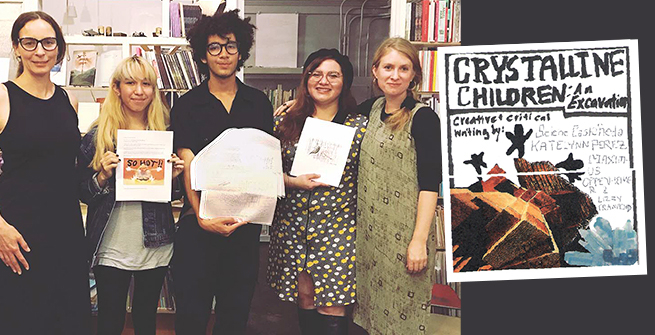Originally from Pennsylvania, New Jersey, and New York City, Elizabeth Crawford came to Los Angeles four and a half years ago. Elizabeth is a Middle and High School librarian and the program coordinator for Humanities in the City. She is particularly interested in Social Justice Pedagogy, Poetry, and Digital Humanities.
Explain Humanities in the City and a bit about the partnership with the Edendale Branch Library.
Humanities in the City is a non-profit organization that I co-founded with Andrea Quaid, and am now the programs coordinator for. When I was the program assistant for a teaching program through Bard College in Los Angeles, we ran a free interdisciplinary college-level Humanities class for public high school juniors in the downtown, Koreatown, and Westlake / MacArthur Park area of Los Angeles. Andrea was the lead teacher for that. After the program ended, the two of us enjoyed doing it so much that we decided to create something similar on our own so we could keep it going. That’s when Humanities in the City was born.
We facilitate college-level interdisciplinary youth workshops (for us Humanities includes a combination of literature, poetry, critical theory, history, politics, visual art, and cultural studies among other fields) around specific themes. We did a summer creative writing workshop at the Edendale Branch Library in 2019, and that’s where we made the zine: Crystalline Children, which is now in Edendale's zine collection.
This week we are launching our website actually at https://humanitiesinthecity.org, and announcing that we are starting workshops again in June (2021) that will be made possible by the California Humanities For All Project Grant in the Youth Voices category.
Why did you choose the zine format for your student's work?
We were doing writing experiments inspired by prompts from various authors and during one of the later classes we started writing little manifestos and personal essays based on an essay called “(Un)natural bridges, (Un)safe spaces” by Gloria Anzaldúa. We started making drawings based on our interpretations of the essay. We were thinking about bridges, liminal spaces, transformation, and experiences of being in-between. The drawings were so fun that we decided that we should gather our writing as a zine to better represent some of our experiments. We knew that we were all going to present our writing at a final celebratory reading, so we felt like it would be great to have something we could hand to people. That way someone could sit down and explore it.
What was the feedback you got from students about creating a collaborative zine?
I observed students enjoy the process of letting their ideas roam off of the traditional page. At the same time, it was a way to formally present their ideas, their poems, essays, drawings, and manifestos directly to an audience. At the reading, students had the opportunity to read directly off of a book they had created. They said that they were proud of their work and felt like their ideas flowed together.
What do you like best about the zine?
My favorite thing about the zine is the students’ ideas and how they connect to each other. The students organized the concept of the zine together based on a manifesto that Katelynn Perez wrote. They heard Katelynn read her piece during our workshop and they all agreed that the phrase “crystalline children” united their ideas together. Katelynn wrote: “You make the effort to get familiar, feel things, touch them, and move your way through as an unstoppable force. The only immovable object in your way is the unknown. In order to excavate, you must become a child.” I love this!! It’s great to see their shared ideas interconnected throughout the zine as well as their unique approaches to processing these ideas through drawings and text.
How do you feel about it being part of the LAPL zine collection?
I got feedback after the workshop from a student who said that they had never really spent time in the library before, and after the workshop, they felt really connected to that space and appreciated it more. I think that we all felt more a part of the Edendale Branch after that experience and now the work that we did during those weeks gets to live on! The students’ sketches and ideas can be explored by other people who are enjoying the library just like we did, and they can look for inspiration and connection in our zine. Pretty rad.
What do you think is the future of zines?
I think that there will be more zines in the future and more zine libraries. I think the library is doing a lot to promote and support people making and sharing zines. I think we need to keep creating zines because there are infinite creative/scholarly / activist / personal/experimental spaces to inhabit, and zines are such an awesome container for doing that. As far as the question about digital versus paper, I don’t really think it matters. I’m really obsessed with print, but I also get that zines will take the forms they need and want to!
Do you have any zine recommendations?
I love zines that feel like a personal blog. I also like finding old zines that carry the passage of time with them. I like zines with lots of images to explore. I don’t like zines that are too slick or feel like they’re for someone’s coffee table.

